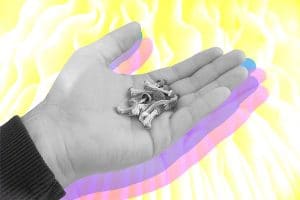Ayahuasca, the potent entheogenic brew from the Amazon Basin, is often consumed as a tool for healing and emotional growth. The name ayahuasca comes from the indigenous Quechua language and translates as “ancestor vine,” “spirit vine,” or “vine of the soul”—perhaps for a very good reason. According to a new study, the compounds in ayahuasca’s traditional preparation—when used under the guidance of a skilled healer known as a curandera or curandero—may help people cultivate acceptance and mindfulness in the aftermath of a loved one’s death.
The International Center for Ethnobotanical Education, Research, and Service (ICEERS) published a study in collaboration with the Beckley Foundation on January 14th finding that ayahuasca ceremony participants experienced significant improvements in their grief symptoms. The severity of grief improved in some way for 92 percent of ceremony participants: Some people experienced profound relief that lasted for at least the full year of the study, while others experienced more moderate—but noticeable—relief from their suffering.
Therapeutic Potential of Ayahuasca in Grief: A Prospective, Observational Study, published in the journal Psychopharmacology, looked at 50 adults who were experiencing grief resulting from the loss of a loved one. Grief symptoms include shock, sadness, anger or bitterness, mistrust, feeling a lack of meaning, and diminished sense of self-worth. Prolonged Grief Disorder (PGD) affects about one in ten adults who experience the loss of a loved one and is defined by intense emotional distress for at least six months. Because it can negatively affect a person’s work and social life, PGD sometimes looks similar to post-traumatic stress disorder (PTSD) and depression.
Read: The Ayahuasca Privilege
Participants in the study responded to a number of assessments for emotional wellbeing and grief symptoms, both prior to the retreat, and afterwards at intervals of two weeks, three months, six months, and 12 months. About 30 percent had previous experience with the psychoactive compounds found in ayahuasca, and all participants took part in four to nine healing ceremonies with indigenous healers at the Temple of the Way of Light in Iquitos, Peru.
While consuming ayahuasca, participants reported a few different kinds of experiences that helped lessen grief. In their altered states, some people welcomed a flood of memories of the deceased while others later described re-encountering—and interacting in some way with— that person. In many cases, participants acknowledged ayahuasca’s help in accepting the reality of the death, while consciously deciding to move forward.
What is Ayahuasca?

Ayahuasca is made from the leaves of a shrub called Psychotria viridis and the stalks or stems of the Banisteriopsis caapi vine. P viridis contains the psychedelic substance, N, N-Dimethyltryptamine (DMT), while B caapi provides monoamine oxidase (MAO) inhibitors—present in certain antidepressants—that helps DMT remain in the body longer and also produces its own psychoactive effects.
How to Grow Shrooms Bundle
Take Both of Our Courses and Save $90!
After a period of purging, many who consume ayahuasca experience some combination of euphoria, visual and auditory hallucinations, and emotional or spiritual insights. Ayahuasca, which has been previously studied for its role in helping people with addiction, depression, PTSD, and anxiety, increases activity in regions of the brain associated with mood regulation and emotions. Ayahuasca is also known to stimulate and protect brain cells, thereby enhancing memory and a person’s capacity for mindfulness.
In this study, researchers found that mindfulness (what they refer to as “decentering,” or the ability to nonjudgmentally observe one’s thoughts and feelings), along with greater acceptance of their losses, together contributed to participants’ relief.
The researchers admit certain limitations to the study, given its “naturalistic” setting lacking in placebo-controlled groups. The scientists’ role was to observe and interpret data—not to administer ayahuasca to participants; thus, the concentration of psychoactive compounds may have varied between ceremonies and between participants. Still, the results of the study speak clearly; ayahuasca may hold profound healing potential for those suffering from loss.
Illustration by Wyeth, N. C. (Newell Convers

DoubleBlind is a trusted resource for news, evidence-based education, and reporting on psychedelics. We work with leading medical professionals, scientific researchers, journalists, mycologists, indigenous stewards, and cultural pioneers. Read about our editorial policy and fact-checking process here.

DoubleBlind Magazine does not encourage or condone any illegal activities, including but not limited to the use of illegal substances. We do not provide mental health, clinical, or medical services. We are not a substitute for medical, psychological, or psychiatric diagnosis, treatment, or advice. If you are in a crisis or if you or any other person may be in danger or experiencing a mental health emergency, immediately call 911 or your local emergency resources. If you are considering suicide, please call 988 to connect with the National Suicide Prevention Lifeline.



